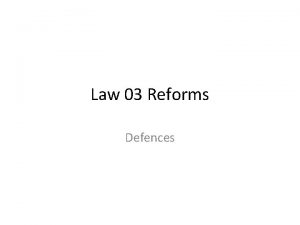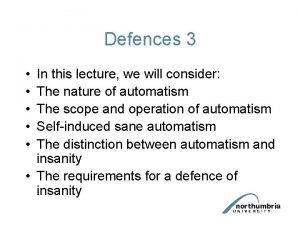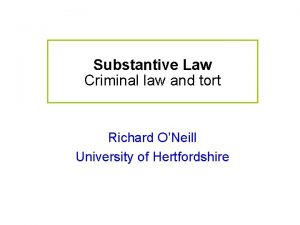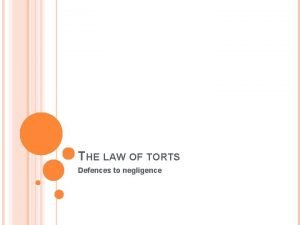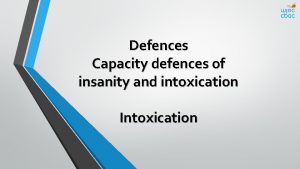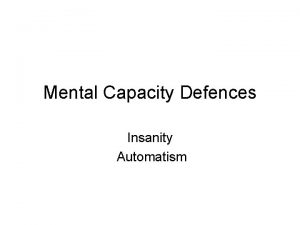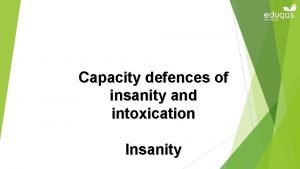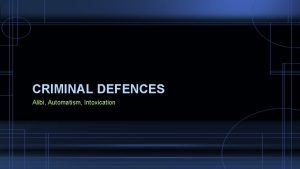Defences Capacity defences of insanity and intoxication Automatism








- Slides: 8

Defences Capacity defences of insanity and intoxication Automatism

Automatism • For automatism to work as a defence, the actions of the defendant must be completely involuntary. • Bratty -v- Attorney General for Northern Ireland (1963) • “an act done by the muscles without any control by the mind, such as a spasm, a reflex action or a convulsion; or an act done by a person who is not conscious of what he is doing such as an act done whilst suffering from concussion or whilst sleep walking”.

Two types of automatism • There are two types of automatism: 1. Insane automatism – this is where the case of automatism is a disease of the mind within the M’Naghten rules. In such cases the defence is insanity and the verdict is guilty by reason of insanity. 2. Non-insane automatism – this is where the cause is an external one and where the defence succeeds it is a complete defence and the defendant is not guilty.

Non-insane automatism • This is a defence because the actus reus is not voluntary and the defendant does not have the required mens rea for the offence • For automatism to work: • it must be caused by an external factor • which causes the defendant to totally lose any control over their actions.

External factors • Examples include a blow to the head, being attacked by bees, a prolonged sneezing fit • Hill -v- Baxter (1958) • Although the defence was not successful in this case the • • court approved the decision in Kay -v- Butterworth (1945) that a person should not be convicted if, through no fault of their own, they lose control due to an external cause. T ( 1990) it was accepted that exceptional stress can be an external factor which may cause automatism , although the defence was not successful in this case. Compare the case of T (1990) with Burgess (1991) Attorney- General’s Reference (No 2 of 1992) (1993) – reduced or partial control of one’s actions is not sufficient to constitute non-insane automatism.

External factors –automatism and diabetes • Quick (1973) • Hypoglycaemia was caused by an external factor as • he had taken his insulin but not eaten and then drunk alcohol. He was able to use automatism as a defence. R -v- Hennessy (1989) Hyperglycaemia was caused by an internal factor, i. e. his diabetes, as he hadn’t taken his insulin. He had to rely on the defence of insanity.

Self-induced automatism • The defence is unlikely to be available if the accused caused the automatism themselves. • • Bailey (1983) • • Hardie (1984) • If the automatism is caused by drink or drugs, the defence will not be available. Defendant was in a hypoglycaemic state as he had taken his insulin but not eaten and then attacked his ex-girlfriend’s new boyfriend with an iron bar. He knew the risks as he had been feeling unwell so his actions were regarded as reckless. Defendant had taken valium which would normally have a calming effect but instead made him very agitated and he set his ex girlfriend’s flat on fire. He was allowed to use the defence.

Proposals for reform • One of the main problems with the defence of automatism is that in each case it has to be decided whether the situation is one of insane or no-insane automatism. • In July 2012 the Law Commission published a paper on the defences of insanity and automatism, the paper is still in its preliminary stages but it pointed out that the two defences are very closely related and that if the defence of insanity is reformed then the defence of automatism must be reformed at the same time.

